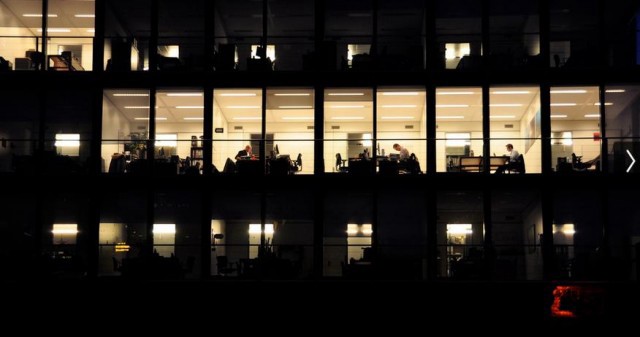Workin’ 9 to 5 (What a Way to Make a Living)
by Megan Reynolds

I have always worked a 40-hour workweek, the sort of traditional 9-to-5, eight hours a day situation that you envision when you think of having a job as a little kid: an ineffectual copy machine in the corner whirring out endless documents, a burbling water cooler that serves as the center for awkward conversation, the communal fridge that gapes with brought-from-home lunches and stray beers. I go to work every day, I sit down at a desk, push a mouse around for a little bit, eat a sad desk salad, and return to my home. This is the glory, this is the life of a modern employee, and for some, the itinerant, the lost the wandering — this is the dream.
I have a friend who has always glamorized the office job, talking to me about how she wished she could just work a “normal” job, like everyone else. At the time, she lived with her boyfriend on a farm outside Boston, doing whatever needed to be done — tending the farm stand, getting a fledgling CSA program off the ground, raising honeybees and harvesting her own honey, all the while enjoying free health care from Massachusetts. While the rest of us withered under the hum of fluorescent lights trying to figure out how to make a pivot table in Excel, she was doing the kind of work that is the dream of the modern office employee — working outside, answering to no one, turning freckled and strong under a summer sun. The work she did was precisely the kind of work that so many earnest office workers turned to after they were worn down by the rat race, leaving New York and starting organic goat cheese companies in Hudson.
The 40-hour workweek is a holdover from the industrial revolution, a relic of the time when manufacturing required human labor, and the demand for mass produced items was high. Factory workers spent ten to sixteen hours a day to keep up with the demand for product. In 1869, the eight-hour workday and minimum wage were put into place for government employees only, with no national precedent. The Haymarket Riots of 1886 were the culmination of years of simmering anger and frustration, drawing over 300,000 workers to Chicago to protest for fair wages and regular hours. Work conditions remained abysmal for the rest of the 19th century, and it wasn’t until the 1950s that the 40-hour workweek and a minimum wage was enforced nationwide.
Because I grew up with the assumption that I would find a job that required me to work a 40-hour week, I can’t shake the feeling that the 9-to-5 grind carries the one hallmark of adulthood — obligation. The work of the modern office employee is finely tuned drudgery, a daily exercise in doing stuff that you don’t necessarily want to do, but know you have to. You make a spreadsheet, you close the spreadsheet. You write 10 emails a day, and sit in a stifling conference room and have a meeting one or two times a week. You derive satisfaction from the small pleasure you take in knowing that if you come to an office, sit at your desk, and look busy for about six hours out of the eight you will get a paycheck every other Friday. The paycheck’s arrival is as dependable as sunrise. The sameness, numbing at times, is comforting.
The freelance hustle is different. Time is slippery, liquid, liable to glide through your fingers if you’re not careful. When you’re in control of your entire day and how you manage your time, it’s another story. In some ways, it’s better. To be able to wake up on a Tuesday at 9 a.m. and know that you can take as much — or as little — time as you need to complete a task creates a certain kind of discipline that the traditional workweek lacks. The job gets done when it gets done, and somehow, the long hours feel less troublesome when you’re able to take the down time when you need it.
Still, the kind of work that we do now is not necessarily dependent on the structure of the eight-hour day. Smartphones mean that the workday has extended indefinitely, extending insidious tentacles outside of its borders, growing like kudzu. The expectation is now that you are always, always on — not as on as you would be at the office, but that your phone is nearby, that any emergency can be handled from anywhere, at any time. Emails are easily answered from the bathroom of a bar, or the pockets of service you get on your train ride home, or while picking out eggplant at the grocery store. Anything can be read as an emergency if it’s coming from the person who’s ultimately paying your bills. We have the choice to ignore the email, to set it aside until morning. The power is in the choice.
Megan Reynolds lives in New York.
Photo: Michiel2005
Support The Billfold
The Billfold continues to exist thanks to support from our readers. Help us continue to do our work by making a monthly pledge on Patreon or a one-time-only contribution through PayPal.
Comments